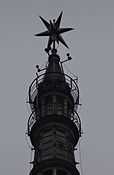Mole Antonelliana


The Mole Antonelliana is a major landmark building in Turin, Italy. It is named for the architect who built it, Alessandro Antonelli. A mole is a building of monumental proportions. Construction began in 1863, soon after Italian unification, and was completed in 1889, after the architect's death. Originally conceived of as a synagogue, it now houses the Museo Nazionale del Cinema, and is the tallest museum in the world.[citation needed]
The building was conceived and constructed as a synagogue. The Jewish community of Turin had enjoyed full civil rights since 1848, and at the time the construction of the synagogue began, Turin was the capital of the new Italian state, a position it held only from 1860 to 1864. The community, with a budget of 250,000 lire and the intention of having a building worthy of a capital city, hired Antonio Antonelli. Antonelli had recently added a 121 metre-high dome and spire to the seventeenth-century Basilica of San Gaudenzio in Novara and promised to build a synagogue for 280,000 lire.[1] The relationship between Antonelli and the Jewish community was not happy. He proposed a series of modifications which raised the final height to 167.5 meters, over 46 meters higher than the dome in the original design. Such changes, in addition to greater costs and construction time than were originally anticipated, did not please the Jewish community and construction was halted in 1869, with a provisional roof.
With the removal of the Italian capital to Florence in 1864, the community shrank, but costs and Antonelli's ambition continued to rise. In 1876, the Jewish community, which had spent 692,000 lire for a building that was still far from finished, announced that it was withdrawing from the project. The people of Turin, who had watched the synagogue rise skyward, demanded that the city take over the project, which it did. An exchange was arranged between the Jewish community and the city of Turin for a piece of land on which a handsome Moorish Revival synagogue was quickly built.[2] The Mole was dedicated to Victor Emmanuel II. Antonelli again began construction, which took the height to 146, 153, and finally 167.5 meters (550 feet). From 1908 to 1938, the city used it to house its Museum of the Risorgimento, which was moved to the Palazzo Carignano in 1938._-_n._3680_-_Torino_-_Tempio_israelitico.jpg)
On 23 May 1953, a violent cloudburst, accompanied by a tornado, destroyed the uppermost 47 metres of the pinnacle, which was rebuilt in 1961 as a metal structure faced with stone.
Since 2000, the building has housed the Museo Nazionale del Cinema (National Museum of Cinema). The Mole appears on the reverse of the two-cent Italian euro coins and was the inspiration for the official emblem of the 2006 Winter Olympics, as well as those of the 2005 World Bocce Championships and the 2006 World Fencing Championships. The building also lent its name to one of Italian football's oldest derbies, between Turin football clubs Torino and Juventus.
On one side of the four-faced dome, the first Fibonacci numbers are written with red neon lights: they are part of the artistic work Il volo dei Numeri ("Flight of the numbers") by Mario Merz.
It was featured in the fourth leg of The Amazing Race 20.
The building (including the interior with its Museum of Cinema) was used extensively in the 2004 Italian film '"Dopo Mezzanotte (After Midnight).

Gallery
|
References
External links
| Wikimedia Commons has media related to Mole Antonelliana. |
- Website of the National Museum of Film (in English)
- The History of the Mole on the Piedmont Regional Site
- Logos of Turin 2006 Winter Olympics and Turin candidacy
Coordinates: 45°04′08″N 7°41′35″E / 45.06889°N 7.69306°E
| |||||


